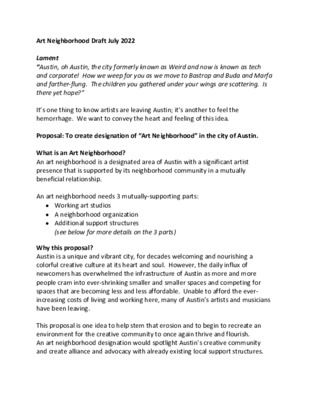Item 16 - Art Neighborhoods Working Group Draft Document — original pdf
Backup

Art Neighborhood Draft July 2022 Lament “Austin, oh Austin, the city formerly known as Weird and now is known as tech and corporate! How we weep for you as we move to Bastrop and Buda and Marfa and farther‐flung. The children you gathered under your wings are scattering. Is there yet hope?” It’s one thing to know artists are leaving Austin; it’s another to feel the hemorrhage. We want to convey the heart and feeling of this idea. Proposal: To create designation of “Art Neighborhood” in the city of Austin. What is an Art Neighborhood? An art neighborhood is a designated area of Austin with a significant artist presence that is supported by its neighborhood community in a mutually beneficial relationship. An art neighborhood needs 3 mutually‐supporting parts: Working art studios A neighborhood organization Additional support structures (see below for more details on the 3 parts) Why this proposal? Austin is a unique and vibrant city, for decades welcoming and nourishing a colorful creative culture at its heart and soul. However, the daily influx of newcomers has overwhelmed the infrastructure of Austin as more and more people cram into ever‐shrinking smaller and smaller spaces and competing for spaces that are becoming less and less affordable. Unable to afford the ever‐ increasing costs of living and working here, many of Austin’s artists and musicians have been leaving. This proposal is one idea to help stem that erosion and to begin to recreate an environment for the creative community to once again thrive and flourish. An art neighborhood designation would spotlight Austin’s creative community and create alliance and advocacy with already existing local support structures. Why art studios? Artists need space to work, whether it be a dance studio, a pottery studio, a theater, a music venue, a spare bedroom, or Lord help us, the less than ideal but often the only place available, but hopefully temporary, the dining room table. Affordability for living space in Austin has become increasingly difficult for almost everybody. Adding the expense of studio working space on top of that makes affordability impossible for many artists. Just as there are not enough places for people to live, there are also few studio spaces left. Many former studio spaces have been bulldozed and replaced with condos. Why a neighborhood organization? Austin lists 1820 different neighborhood organizations, as well as over 80 neighborhood associations. Rather than creating a new organization, it would be an advantage to find a group that already exists, that already has vested interest and experience advocating for their neighborhood. Neighborhood organizations exist to assist and advocate for the people who occupy a shared space. (see https://www.atxanc.org/ and ftp://ftp.ci.austin.tx.us/GIS‐Data/Regional/coa_community_registry_map_finder.html) Why additional support structures? It takes a village… or a neighborhood… as well as the city. Everything is connected to everything and everybody is connected to everybody. We are not alone, creativity is for everybody, and we look to live and work in flourishing integrated community. Additional support could be galleries, restaurants with space for artist work for sale, libraries with meeting places and gallery spaces, churches/faith groups or service clubs like Rotary and Lions with performing, meeting or gallery space, etc. Why the name Art Neighborhood? Many cities have designated Art Districts, but an Art Neighborhood would be different. A district is a region set aside for political or administrative purposes. A neighborhood is a social community and network with considerable face‐to‐face interaction. District is about division, a political divide. Neighborhood says inclusion. Art neighborhood says we are neighbors, living nearby and next to each other, and should be supportive of each other. Austin already is divided into 10 city council districts, 16 residential zoning districts, 13 commercial districts, 4 industrial districts, and 5 special purpose base districts. Making up our own term and our own definition speaks of our creativity. What are the benefits? Mutual advocacy Building community Strength in numbers Support for events Help build citywide directory of resources Veil of protection Possibility of stronger ties to technologies and corporations that rely on innovation to compete How would a neighborhood become an Art Neighborhood? 1. Get an application from the city 2. Inventory studios, neighborhood organization(s), support structures 3. Submit the application 4. Get city staff and Arts Commission approval (and city council acknowledgement) What would show the art neighborhood designation? At the minimum, the city would provide signage. Keystone Species In architecture, the keystone or capstone is the hallmark of strength, on which all of the other stones in an arch depend. In biology, keystone species are organisms in an ecosystem that all the other species depend on, that without them, the ecosystem would be dramatically different or cease to exist altogether. In Austin, the creative members are the keystone species, the group that Austin depends on for its uniqueness, the key feature of our identity. Conclusion Help!